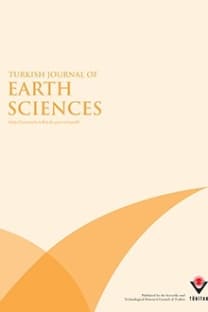Stratigraphy and some structural features of the İstanbul Paleozoic
Palaeozoic rocks crop out across large areas in the İstanbul region. The Palaeozoic sequence starts with the Lower Ordovician fluviatile and lacustrine deposits (Kocatöngel and Kurtköy formations). The area was transgressed by the sea during the Late Ordovician-Early Silurian, represented by the feldspathic quartzwacke and quartz-arenites of the Kınalıada and Aydos formations. The basin became progressively deeper and more stable during the Silurian and Devonian. In this period, micaceous siltstones and sandstones of the Yayalar Formation (Upper Ordovician (?)-Lower Silurian), shelf-type carbonates of the Pelitli Formation (Lower Silurian-Lower Devonian), fossil-rich micaceous shales with rare limestone intercalations representing a low-energy open shelf environment (Pendik Formation, Lower-Middle Devonian) and nodular limestones, formed in an open shelf to slope setting (Denizli Köyü Formation, Upper Devonian-Lower Carboniferous), were deposited. Lower Carboniferous black lydites, which form horizons within the Denizli Köyü Formation, and also constitute a marker horizon at the top of the formation, imply a source with a high silica content. The basin, which was tectonically stable from the Ordovician to the beginning of the Carboniferous, became a site of turbiditic flysch deposition (Trakya Formation) and tectonically active during the Early Carboniferous. Tectonic movements in the Carboniferous-Permian period resulted in the deformation and intrusion of the Permian Sancaktepe granitoid. The Variscan deformation probably involved east-west contraction resulting in north-south-trending asymmetric folds and thrusts, which resulted in the uplift of the region, followed by the deposition of Permian (?)-Lower Triassic fluviatile red clastics over large areas.
Stratigraphy and some structural features of the İstanbul Paleozoic
Palaeozoic rocks crop out across large areas in the İstanbul region. The Palaeozoic sequence starts with the Lower Ordovician fluviatile and lacustrine deposits (Kocatöngel and Kurtköy formations). The area was transgressed by the sea during the Late Ordovician-Early Silurian, represented by the feldspathic quartzwacke and quartz-arenites of the Kınalıada and Aydos formations. The basin became progressively deeper and more stable during the Silurian and Devonian. In this period, micaceous siltstones and sandstones of the Yayalar Formation (Upper Ordovician (?)-Lower Silurian), shelf-type carbonates of the Pelitli Formation (Lower Silurian-Lower Devonian), fossil-rich micaceous shales with rare limestone intercalations representing a low-energy open shelf environment (Pendik Formation, Lower-Middle Devonian) and nodular limestones, formed in an open shelf to slope setting (Denizli Köyü Formation, Upper Devonian-Lower Carboniferous), were deposited. Lower Carboniferous black lydites, which form horizons within the Denizli Köyü Formation, and also constitute a marker horizon at the top of the formation, imply a source with a high silica content. The basin, which was tectonically stable from the Ordovician to the beginning of the Carboniferous, became a site of turbiditic flysch deposition (Trakya Formation) and tectonically active during the Early Carboniferous. Tectonic movements in the Carboniferous-Permian period resulted in the deformation and intrusion of the Permian Sancaktepe granitoid. The Variscan deformation probably involved east-west contraction resulting in north-south-trending asymmetric folds and thrusts, which resulted in the uplift of the region, followed by the deposition of Permian (?)-Lower Triassic fluviatile red clastics over large areas.
